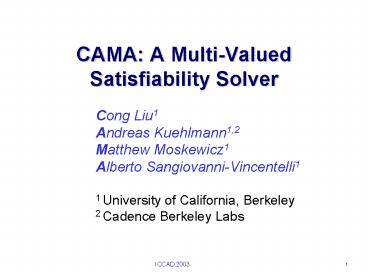CAMA: A MultiValued Satisfiability Solver - PowerPoint PPT Presentation
1 / 21
Title:
CAMA: A MultiValued Satisfiability Solver
Description:
A multi-valued clause is a logical disjunction of one or more MV literals. A formula in multi-valued conjunctive normal form (MV-CNF) is the logical ... – PowerPoint PPT presentation
Number of Views:51
Avg rating:3.0/5.0
Title: CAMA: A MultiValued Satisfiability Solver
1
CAMA A Multi-Valued Satisfiability Solver
- Cong Liu1
- Andreas Kuehlmann1,2
- Matthew Moskewicz1
- Alberto Sangiovanni-Vincentelli1
1 University of California, Berkeley
2 Cadence Berkeley Labs
2
Outline
- Motivation
- Preliminaries
- Solver Architecture
- MV Decision Heuristic
- MV Watch Literal Scheme
- MV Learning
- Results
- Conclusions
3
Motivation
- MV logic can describe many CAD decisions
naturally - Choose one out of n, e.g. technology mapping
- Application of binary SAT solver requires
encoding - One-hot encoding one binary variable represents
one value of a MV variable - e.g.
- Binary encoding
- Additional clauses to exclude invalid values
4
Motivation
- MV formulations can describe binary SAT problems
more compactly - E.g. by clustering Boolean circuits
- 7 Binary variables, 43 clauses
- 5 MV variables (y1 4-value, y2 8-value), 32 MV
clauses - Preprocess cluster
5
Preliminaries
- Let xi denote a multi-valued variable with domain
Pi 0,1,,Pi-1. - xi is assigned to a non-empty value set vi, if xi
can take any value from vi Í Pi but no value
from Pi \ vi - if vi 1, completely assigned, e.g. x
2 - otherwise incompletely assigned, e.g. x 0,2
- A multi-valued literal is the Boolean
function defined by - where is the literal value
set
6
Preliminaries
- A multi-valued clause is a logical disjunction of
one or more MV literals. - A formula in multi-valued conjunctive normal form
(MV-CNF) is the logical conjunction of a set of
multi-valued clauses. - A MV SAT problem given in MV-CNF is
- Satisfiable if there exists a set of complete
assignments to all variables such that the
formula evaluates to true. - It is unsatisfiable if no such assignment exists.
7
Resolution
- Recall Binary clause resolution
- variable x is eliminated
- MV resolution provides generalized case
- take intersection of literal value sets of the
resolving variable x
8
General Solver Flow
Algorithm DPLL () while (decide ()
SUCCESS) while (deduce () CONFLICT)
if (analyze_conflict () FAILURE)
return UNSAT
return SAT
9
Decision Heuristic
- Binary case either 0 or 1 is assigned
- MV Case (2P-2) possible assignments initially
- E.g. P0,1,2 0, 1, 2, 0,1, 0,2,
1,2 - Large decision scheme
- Pick one value from value set of selected
variable - Max depth of decision stack variables n
- Learning by contra-positive only forbids one
value - Small decision scheme
- Exclude one value
- Max depth of decision stack
10
Watch-literal Scheme
- Similar to Chaff-class solvers
- Watch two literals and swap them with non-false
literals as soon as they become false - If no such literal exist ? implication
- No implication as long as watch literals not
false - Differences
- Only one linked list for each MV variable
- Process clause only when literal evaluates to
false
11
Boolean Constraint Propagation
12
Conflict Analysis
- Grasp Chaff wisdom we can learn the
contra-positive for any cut assignment - Grasp Chaff suggest to use cut with exactly one
literal on current decision level - Unique implication point (UIP)
Assignment(Cuti) Þ Conflict Not(Conflict) Þ
Not(Assignment(Cuti))
13
Conflict Analysis
- Cut at x3 and x4 as first UIP
- By contra-positive we learn
14
However
- Learned clauses are actually generated by a
sequence of resolution steps - IG is processed in reverse implication order
starting from the conflicting clause as
accumulator clause. - At each step the accumulator clause is resolved
with the clause causing the implication, using
the implied variable as the resolving variable. - Binary case
- The result of the resolution sequence is
identical to the contra-positive of the cut
assignments - For MV-SAT this is not the case
15
MV-Conflict Analysis
16
MV-Conflict Analysis
17
MV-Conflict Analysis
- The learned clause is strictly stronger than
the cut clause - Cut clause forbids
- Learned clause forbids
- As if decisions were
Never visited before
Bigger search space
18
Implementation Details
- Minimum Value Set (MVS) algorithm builds learned
clause in one traversal of IG - Original Assignment Storage (OAS) facilitates
undo assignment - Value sets are represented by sets of bits
- Positional notation
- Allow efficient bit-parallel operation
- Flexibility of processing incomplete assignments
- A decision-level stack for each variable
19
Results
- Compare Cut-negation learning with MVS learning
20
Results
- Equivalence checking of a MV function before and
after applying MVSIS
21
Conclusions
- Many CAD decision problems can be modeled as MV
SAT problems - Avoid encoding and additional constraint clauses
- Specialized MV SAT solver has advantages
- Bit-parallel processing of value sets
- Learning based on MV-resolution can prune search
space never visited before - Flexibility by using incomplete assignments
- Corresponding speedup observed when comparing
with binary solver































![READ⚡[PDF]✔ 2024 People Magazine Crossword Puzzle For the Thoughtful Solver: Fun and PowerPoint PPT Presentation](https://s3.amazonaws.com/images.powershow.com/10081731.th0.jpg?_=20240719105)